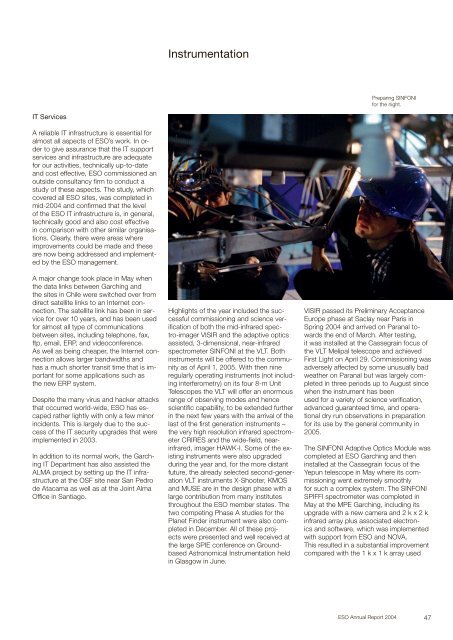ESO Annual Report 2004
ESO Annual Report 2004
ESO Annual Report 2004
- TAGS
- annual
- www.eso.org
Create successful ePaper yourself
Turn your PDF publications into a flip-book with our unique Google optimized e-Paper software.
IT Services<br />
A reliable IT infrastructure is essential for<br />
almost all aspects of <strong>ESO</strong>’s work. In order<br />
to give assurance that the IT support<br />
services and infrastructure are adequate<br />
for our activities, technically up-to-date<br />
and cost effective, <strong>ESO</strong> commissioned an<br />
outside consultancy firm to conduct a<br />
study of these aspects. The study, which<br />
covered all <strong>ESO</strong> sites, was completed in<br />
mid-<strong>2004</strong> and confirmed that the level<br />
of the <strong>ESO</strong> IT infrastructure is, in general,<br />
technically good and also cost effective<br />
in comparison with other similar organisations.<br />
Clearly, there were areas where<br />
improvements could be made and these<br />
are now being addressed and implemented<br />
by the <strong>ESO</strong> management.<br />
A major change took place in May when<br />
the data links between Garching and<br />
the sites in Chile were switched over from<br />
direct satellite links to an Internet connection.<br />
The satellite link has been in service<br />
for over 10 years, and has been used<br />
for almost all type of communications<br />
between sites, including telephone, fax,<br />
ftp, email, ERP, and videoconference.<br />
As well as being cheaper, the Internet connection<br />
allows larger bandwidths and<br />
has a much shorter transit time that is important<br />
for some applications such as<br />
the new ERP system.<br />
Despite the many virus and hacker attacks<br />
that occurred world-wide, <strong>ESO</strong> has escaped<br />
rather lightly with only a few minor<br />
incidents. This is largely due to the success<br />
of the IT security upgrades that were<br />
implemented in 2003.<br />
In addition to its normal work, the Garching<br />
IT Department has also assisted the<br />
ALMA project by setting up the IT infrastructure<br />
at the OSF site near San Pedro<br />
de Atacama as well as at the Joint Alma<br />
Office in Santiago.<br />
Instrumentation<br />
Highlights of the year included the successful<br />
commissioning and science verification<br />
of both the mid-infrared spectro-imager<br />
VISIR and the adaptive optics<br />
assisted, 3-dimensional, near-infrared<br />
spectrometer SINFONI at the VLT. Both<br />
instruments will be offered to the community<br />
as of April 1, 2005. With then nine<br />
regularly operating instruments (not including<br />
interferometry) on its four 8-m Unit<br />
Telescopes the VLT will offer an enormous<br />
range of observing modes and hence<br />
scientific capability, to be extended further<br />
in the next few years with the arrival of the<br />
last of the first generation instruments –<br />
the very high resolution infrared spectrometer<br />
CRIRES and the wide-field, nearinfrared,<br />
imager HAWK-I. Some of the existing<br />
instruments were also upgraded<br />
during the year and, for the more distant<br />
future, the already selected second-generation<br />
VLT instruments X-Shooter, KMOS<br />
and MUSE are in the design phase with a<br />
large contribution from many institutes<br />
throughout the <strong>ESO</strong> member states. The<br />
two competing Phase A studies for the<br />
Planet Finder instrument were also completed<br />
in December. All of these projects<br />
were presented and well received at<br />
the large SPIE conference on Groundbased<br />
Astronomical Instrumentation held<br />
in Glasgow in June.<br />
Preparing SINFONI<br />
for the night.<br />
VISIR passed its Preliminary Acceptance<br />
Europe phase at Saclay near Paris in<br />
Spring <strong>2004</strong> and arrived on Paranal towards<br />
the end of March. After testing,<br />
it was installed at the Cassegrain focus of<br />
the VLT Melipal telescope and achieved<br />
First Light on April 29. Commissioning was<br />
adversely affected by some unusually bad<br />
weather on Paranal but was largely completed<br />
in three periods up to August since<br />
when the instrument has been<br />
used for a variety of science verification,<br />
advanced guaranteed time, and operational<br />
dry run observations in preparation<br />
for its use by the general community in<br />
2005.<br />
The SINFONI Adaptive Optics Module was<br />
completed at <strong>ESO</strong> Garching and then<br />
installed at the Cassegrain focus of the<br />
Yepun telescope in May where its commissioning<br />
went extremely smoothly<br />
for such a complex system. The SINFONI<br />
SPIFFI spectrometer was completed in<br />
May at the MPE Garching, including its<br />
upgrade with a new camera and 2 k x 2 k<br />
infrared array plus associated electronics<br />
and software, which was implemented<br />
with support from <strong>ESO</strong> and NOVA.<br />
This resulted in a substantial improvement<br />
compared with the 1 k x 1 k array used<br />
<strong>ESO</strong> <strong>Annual</strong> <strong>Report</strong> <strong>2004</strong><br />
47

















